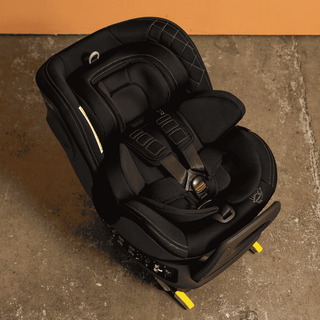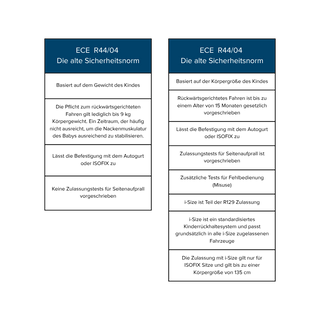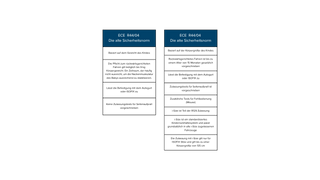

Sicher unterwegs mit AVOVA
Was ECE und i-Size bei Kindersitzen wirklich bedeuten
Europäische Sicherheits-Normen
Jedes Kind in Europa muss bis zu einem Alter von 12 Jahren oder einer Körpergröße von 150 cm in einem Kindersitz im Auto mitfahren. Zwischen 0 und 12 Jahren verändert sich der Körper deines Kindes unentwegt. Da kann es recht schwierig werden, immer den passenden Kindersitz auszuwählen. Um dir dabei zu helfen, gibt es genaue Sicherheits-Standards und gesetzliche Bestimmungen. Wir klären dich über die aktuellen gesetzlichen Normen auf.
Was steht auf dem orangenen Prüfzeichen?
Das orangene Prüfzeichen ist ein wichtiger Teil deines
Kindersitzes. Nur mit diesem Zeichen ist dein Kindersitz gesetzlich zugelassen.
Es sagt Folgendes über deinen Kindersitz aus:


1. Produktname
2. Typengenehmigung
3. Europäische Prüf- und Zulassungsnorm (R129)
4. Europäischer Zulassungsindikator
1 = Deutschland; 2 = Frankreich; ...
5. Zulassungsnummer
6. Name und Adresse des Herstellers
7. Seriennummer des Sitzes
Was ist i-Size?
i-Size ist Teil der neuen Zulassungsnorm R-129 und unterstützt ISOFIX als beste Befestigungsmethode für erhöhte Sicherheit. ISOFIX wurde entwickelt, da viele Kindersitze, die den 3-Punkt-Gurt eines Autos nutzen, falsch oder fehlerhaft befestigt werden. i-Size gilt für Kindersitze, die Kinder von Geburt bis zu einer Körpergröße von 135 cm sichern.
Mit der Einführung von i-Size bleibt die alte Zulassungsnorm ECE R44/04 noch für mindestens fünf Jahre gültig.
Viele Eltern wollten von uns wissen, welche Unterschiede zwischen ECE R44/04 und R-129 bestehen. Deswegen haben wir hier für dich einen kleinen Überblick:


Es gibt noch einen weiteren großen Unterschied zwischen R44 und R-129:
Für R-129 werden bei den Crash-Tests Dummies benutzt, die mit besonders vielen Mess-Sensoren ausgestattet sind. Diese erlauben eine bessere Datenerfassung. Die sogenannten Q-Dummies reagieren außerdem realitätsnaher als die P-Dummies, die bei den Tests für R44 verwendet werden.
i-Size steht für mehr Sicherheit und eine einfachere Handhabung.
ECE R44/04 – die bisherige Zulassungsnorm für Autokindersitze in Europa
Die Zulassungsnorm der ECE (Economic Commission for Europe) R44/04 trat 2005 in Kraft. Sie unterscheidet 5 Kindersitz-Kategorien, auch bekannt als Gruppen. Jede Gruppe steht für eine bestimmte Alters- und Gewichtsklasse. Die Zulassungsnorm erlaubt aber auch sogenannte Kombinations-Gruppen, die gleich mehrere Alters- und Gewichtsklassen beinhalten. Das macht das Auswählen des passenden Kindersitzes für viele Eltern unnötig kompliziert.
Alle Kindersitze, die der Norm ECE R44/04 entsprechen, können weiterhin verwendet werden. Sieh dir dazu das orangene Prüfzeichen an deinem Kindersitz an. Alle vorherigen Sicherheitsnormen sind nicht mehr zulässig. Deswegen solltest du die entsprechenden Kindersitze nicht mehr benutzen.
Du bist dir unsicher, ob dein Kindersitz der gängigen Zulassung entspricht?
Dann melde dich bei uns. Wir helfen dir gerne weiter!